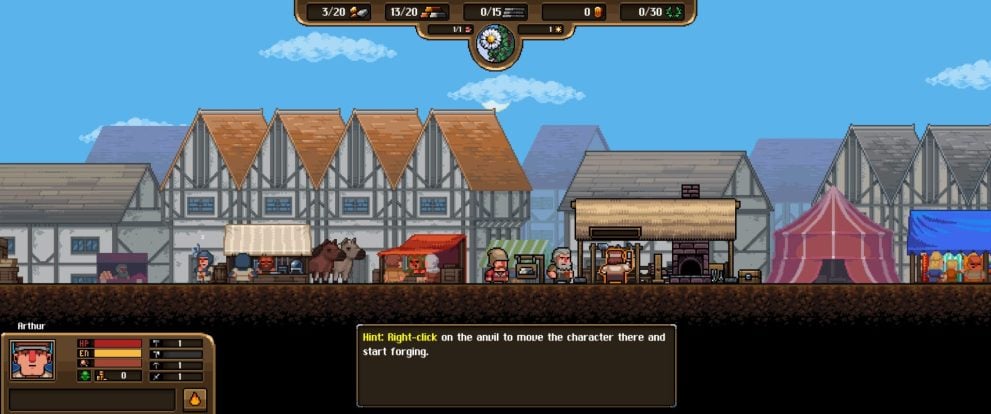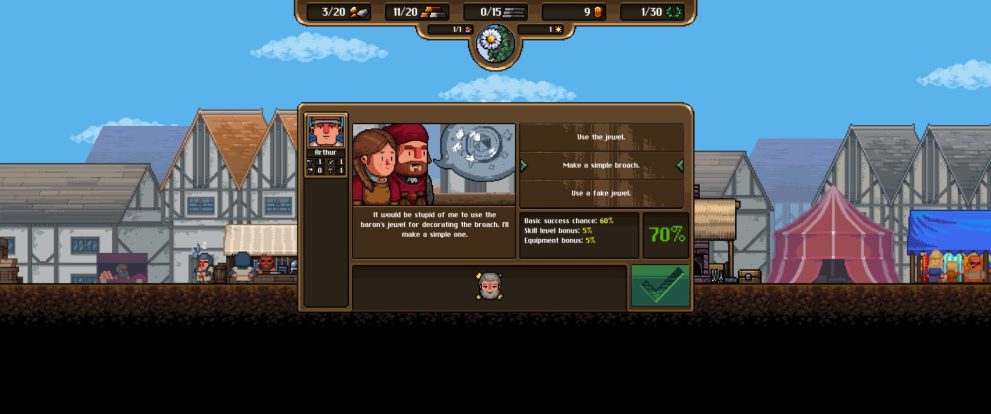I first caught wind of Pirozhok Studio and HeroCraft’s Anvil Saga about a month ago when a press release showed up in my inbox. The pitch was simple: play as a blacksmith during the Hundred Year War and supply weapons to all factions involved while slowly expanding your shop and improving your craft. Sounds pretty straightforward, and I’m a sucker for management sims so this seemed right up my alley.
I got to check out a demo build of Anvil Saga this past week, and while it definitely has some obvious flaws that still need to be sorted out, this game is pretty much everything I’d hoped for just from seeing the trailer, and I’m excited to see the finished product.
Players take charge of Arthur, a blacksmith who take over his father’s craft after he passes away. Each day, you’ll smelt ore into ingots, then use those ingots to fulfill equipment orders. Things seem straightforward at first, but gradually, you’re given more tasks to manage. You need to start mining for ore so you can smelt them into more ingots, you need to watch Arthur’s energy and make sure to rest up when he’s tired, you need to buy food to prevent him from getting hungry… the list goes on.
On top of all that, there is a time limit to your orders as well; wait too long, and a customer will walk away angrily, and they might even spread the word that your smithy is unreliable, lowering the number of customers you get.

Eventually, all of the tasks become way too much for you to handle, and that’s where your apprentices come in. Now, you have more workers to manage and you need to watch their energy meters, but it’s much easier to divvy up the work and run the smithy more efficiently.
Slowly, you’ll start to expand the smithy itself, building rooms, furnishing them to accommodate your apprentices, and you’ll also get to build more facilities and unlock more resources for more complex crafting orders. It’s all fairly standard stuff, until Anvil Saga reveals that you have key decisions to make throughout the course of the story.
For instance, an early game customer approached me with a rare jewel for an order, and I had the choice of either completing the order or giving it away. There are consequences for whichever choice you make, and while the demo wasn’t quite big enough to show just how far-reaching these consequences can be, it does add a bit of replay value to the game as I already found myself wanting to restart and see how things would go if I picked a different choice.

For all of its strengths, though, Anvil Saga is still bogged down with a few issues that made my gameplay experience less than pleasant. Directing your individual workers to perform certain tasks feels clumsy, and the game needs better indicators to show you who you’re in control of at any given moment. It would also be nice to have some sort of indication of what each worker is doing at all times, as I could see the game becoming very hectic as you get more workers to manage and more complex tasks to fulfill.
Every now and then, I also noticed that the tutorial prompts and tooltips would show up in Russian despite having picked English as my language option, which made it a little difficult to determine exactly what I’m supposed to do. That should be fixed in the final build, of course, but all of these little issues came together and made Anvil Saga a lot less fun than it should’ve been.
That being said, bugs and glitches aside, Anvil Saga pretty much checks every box I have for a management sim game. The pixel art style is pretty, the music is charming, and it’s definitely worth checking out if you’re a fan of the genre.
